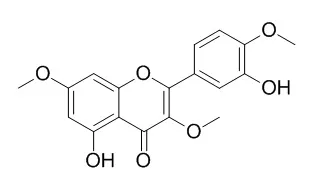| In vitro: |
| Biochem Biophys Res Commun. 2012 Nov 9;428(1):116-20. | | Ayanin diacetate-induced cell death is amplified by TRAIL in human leukemia cells.[Pubmed: 23063980] | Here we demonstrate that the semi-synthetic flavonoid Ayanin diacetate induces cell death selectively in leukemia cells without affecting the proliferation of normal lymphocytes.
METHODS AND RESULTS:
Incubation of human leukemia cells with Ayanin diacetate induced G(2)-M phase cell cycle arrest and apoptosis which was prevented by the non-specific caspase inhibitor z-VAD-fmk and reduced by the overexpression of Bcl-x(L). Ayanin diacetate-induced cell death was found to be associated with: (i) loss of inner mitochondrial membrane potential, (ii) the release of cytochrome c, (iii) the activation of multiple caspases, (iv) cleavage of poly(ADP-ribose) polymerase and (v) the up-regulation of death receptors for TRAIL, DR4 and DR5. Moreover, the combined treatment with Ayanin diacetate and TRAIL amplified cell death, compared to single treatments.
CONCLUSIONS:
These results provide a basis for further exploring the potential applications of this combination for the treatment of cancer. |
|
| In vivo: |
| Eur J Pharmacol. 2010 Jun 10;635(1-3):198-203. | | Ayanin, a non-selective phosphodiesterase 1-4 inhibitor, effectively suppresses ovalbumin-induced airway hyperresponsiveness without affecting xylazine/ketamine-induced anesthesia.[Pubmed: 20307524 ] | In recent in vitro reports, the IC(50) value of Ayanin (quercetin-3,7,4'-O-trimethylether) was 2.2microM for inhibiting interleukin (IL)-4 production from purified basophils, and its therapeutic ratio was >19.
Therefore, we were interested in investigating the effects on ovalbumin induced airway hyperresponsiveness in vivo, and to clarify its potential for treating asthma.
METHODS AND RESULTS:
Ayanin (30-100micromol/kg, orally (p.o.)) dose-dependently and significantly attenuated the enhanced pause (P(enh)) value induced by methacholine in sensitized and challenged mice. It also significantly suppressed the increases in total inflammatory cells, macrophages, lymphocytes, neutrophils, and eosinophils, and levels of cytokines, including IL-2, IL-4, IL-5, and tumor necrosis factor (TNF)-alpha in bronchoalveolar lavage fluid of these mice. However, at 100micromol/kg, it significantly enhanced the level of interferon (IFN)-gamma. In addition, Ayanin (30-100micromol/kg, p.o.) dose-dependently and significantly suppressed total and OVA-specific immunoglobulin (Ig)E levels in the serum and bronchoalveolar lavage fluid, and enhanced the IgG(2a) level in serum of these mice.
CONCLUSIONS:
In the present results, Ayanin did not affect xylazine/ketamine-induced anesthesia, suggesting that Ayanin has few or no adverse effects, such as nausea, vomiting, and gastric hypersecretion. In conclusion, the above results suggest that Ayanin may have the potential for use in treating allergic asthma. |
|






 Cell. 2018 Jan 11;172(1-2):249-261.e12. doi: 10.1016/j.cell.2017.12.019.IF=36.216(2019)
Cell. 2018 Jan 11;172(1-2):249-261.e12. doi: 10.1016/j.cell.2017.12.019.IF=36.216(2019) Cell Metab. 2020 Mar 3;31(3):534-548.e5. doi: 10.1016/j.cmet.2020.01.002.IF=22.415(2019)
Cell Metab. 2020 Mar 3;31(3):534-548.e5. doi: 10.1016/j.cmet.2020.01.002.IF=22.415(2019) Mol Cell. 2017 Nov 16;68(4):673-685.e6. doi: 10.1016/j.molcel.2017.10.022.IF=14.548(2019)
Mol Cell. 2017 Nov 16;68(4):673-685.e6. doi: 10.1016/j.molcel.2017.10.022.IF=14.548(2019)